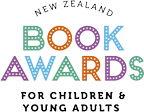Judge’s Report, New Zealand Book Awards for Children and Young Adults 2015
At the beginning of the judging process, I likened the process of judging to be like a vintner looking forward to tasting this year’s vintage. Having tasted, the judges were well-pleased with the quality of the writing entered in these awards this year.
There were 149 entries formed by 76 picture books, 35 junior fiction, 21 young adult fiction and 17 non-fiction books. There were a number of self-published books, including two electronic format entries, some of which suffered from a need for a strong editorial direction in structure, characterisation and plotline. Other self- and traditionally-published works displayed cohesion and excellence in the finished product.
The Non-Fiction entries were particularly impressive, almost in defiance of the pressure for some libraries to dispense with their non-fiction resources, in favour of electronic sources of information. It is fair to say that the wide variety of the non-fiction entries presented information that was superior to any single electronic source of information. The publishers are to be commended for the range of material published.
Competition in the Picture Book category is always intense and this year was no exception. Most entries were visually strong with digital imaging often supplanting more traditional forms of illustration. Unfortunately, written text was not always well executed, with a trend to use rhyming language that was at times forced and not wholly in harmony with the illustrations. Cover design was, for the most part, of a high standard. The most animated discussion by judges was around the picture books and it is fair to say we could have picked 10 titles that were at a similar brilliant level as the final five. Having said that, the final five are outstanding picture books that cater to a wide range of readers.
There were 35 entries in the Junior Fiction category and they were a delight to read, with two of the final five combining comic book illustrations within a traditional novel format, and four having an historical connection. Fantasy and adventure also figure, with an anti-bullying link showing up in the finalists list. Cover design was mostly appropriate and engaging, certainly in the final five. We were especially pleased that a full range of reading levels were catered to within this category.
The 21 entries in the Young Adult Fiction category were impressive, and in my experience, probably the strongest in many years. The human condition and teenage relationships were intimately discussed and dialogue was a strong feature of all novels. However, cover design did not always reflect the internal content as strongly.
The practice for each judge of creating a long list as they read, works well. It helps to simplify the selection of the final five in each category. The judges did not always agree that an entry in a specific category was accurate for some books, and publishers should be sure of the entry conditions in this area. The border between young adult and junior fiction was often a moot point, with some books crossing over between categories. Picture books were passionately discussed as were the final additions to each category, but all judges agreed with the final selections, as befitted the quality and knowledge of the three judges. Much time was spent discussing the Māori Language Award and we consider that some distinction has to be made in the future between a book written firstly in Te Reo Māori, as distinct from one that is a translation.
Bob Docherty, Convenor

